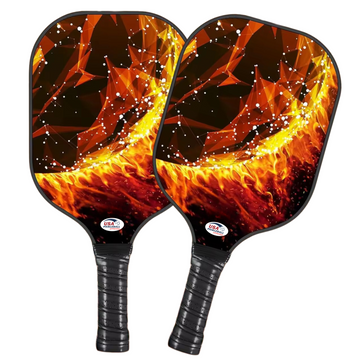Choosing the right pickleball paddle depends on the player. The way he moves, strikes, and defends on the court. Different paddles offer various benefits like power, control, or maneuverability. To pick the best paddle, a player should match the following to their unique playing style and skill;
-
weight
-
shape
-
grip
Not all paddles are created equal. Find the one that matches your style
Some players prefer lightweight paddles for quick reactions. While others want heavier paddles to add power behind their shots. Understanding the players preference, helps them feel comfortable and perform better in games.
Knowing the paddle’s materials and surface texture also plays a role in selecting the right one. When players choose features that match their style, the game becomes easier and more fun.
Understanding Pickleball Paddle Types
Pickleball paddles vary in their materials, core construction, and surface finishes. Each factor affects the paddle’s weight, durability, control, and power. This helps players match paddles to their style.
Materials and Construction
Paddle materials are from wood, composite, or graphite. Wood paddles are the heaviest and least expensive. Usually suitable for beginners or casual play. Composite paddles combine layers of fiberglass or carbon fiber over a core. Offering balance between weight and power. Graphite paddles are the lightest and most responsive. Preferred by players seeking speed and precision.
The construction quality affects feel and durability. A sturdy paddle with good edge guard protection lasts longer. While lighter materials improve maneuverability.
Core Types and Their Impact
The paddle core determines touch and power. Common core materials include polymer, nomex, and aluminum honeycomb.
Polymer cores are soft and quiet, providing good control but moderate power.
Nomex cores are firm and absorb less shock, generating more power but less control.
Aluminum honeycomb cores lie between polymer and nomex, offering a balance of responsiveness and durability.
Players who prioritize control tend to choose polymer cores, while aggressive hitters might prefer nomex cores.
Surface Textures and Finishes
Paddle surfaces vary to enhance spin and ball control. Rough or textured finishes help grip the ball for more spin during shots.
Smooth finishes allow for faster ball rebounds, adding power but reducing spin potential.
Some paddles have a matte finish, reducing glare and improving feel, while glossy surfaces may wear down faster but offer a sleek look.
Choosing the right surface depends on whether a player favors spin or quicker hits.
Matching Paddle Features to Playing Style
Choosing a paddle means balancing power, control, weight, and grip to fit how someone plays. Each feature affects performance differently, so understanding their impact helps find the best match.
Power vs. Control Paddles
Power paddles have a harder core and often larger sweet spots. They work well for aggressive players who want strong drives and fast shots. These paddles typically have a thicker face that adds pop but can reduce finesse.
Control paddles are lighter and have softer cores. They suit players who prefer precision, dinking, and placing shots carefully. The softer core absorbs impact and lets players feel the ball better, improving maneuverability.
Players focused on rallies and placement often favor control paddles, while those aiming to finish points quickly lean toward power paddles. The choice depends on what shot style dominates their game.
Weight Preferences and Effects
Paddle weight affects swing speed and endurance. Heavier paddles (around 8.5–9.5 ounces) offer more power and stability on volleys but may tire arms faster.
Lighter paddles (6.5–7.5 ounces) increase maneuverability and reduce fatigue, helping with quick reactions and long matches. However, they usually give less power with each hit.
Speed, comfort, and control — all in one paddle
Many players choose a midweight (7.5–8.5 ounces) paddle to balance control and power. Weight choice often reflects physical strength and preferred play pace.
Handle Length and Grip Size
Handle length varies from about 4 to 5 inches. Longer handles allow two-handed backhands and greater leverage. Shorter handles improve wrist control and quick wrist snaps.
Grip size should match hand size to prevent strain or slipping. Small grips (4 to 4 1/4 inches) suit players with smaller hands, promoting better reach and quicker reaction.
Comfort meets control — it all starts with the right grip
Larger grips (4 1/2 to 4 3/4 inches) provide more stability but reduce wrist flexibility. Choosing the correct grip improves comfort and control during play.
Additional Factors to Consider
Choosing the right paddle also involves meeting official standards and balancing cost with quality. Understanding these practical elements helps players select a paddle that fits both competitive and personal needs.
USAPA Approval and Regulations
The USA Pickleball Association (USAPA) sets specific rules for paddles used in official play. Paddles must be on the USAPA’s approved list to be tournament-legal. This includes size, shape, and material restrictions.
Players should check the USAPA approved paddle list regularly, as it updates with new models. Paddles exceeding size limits (generally 24 inches long and 8 inches wide) or made from banned materials will be disqualified in official games.
Approval matters most for competitive players who plan to enter sanctioned tournaments. Casual players can focus on feel and control but should still be aware of these guidelines to avoid surprises if they decide to compete.
Game-ready, rule-approved — trust in a USAPA-certified paddle
Budget and Brand Options
Pickleball paddles range widely in price, typically from $30 to over $200. While higher-priced paddles often offer better materials like carbon fiber or specialized polymer cores, affordable paddles still provide solid performance for beginners.
Players should balance budget with desired paddle features. Testing paddles in stores or borrowing before buying can prevent overspending on equipment that may not suit their style.


